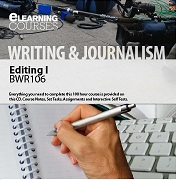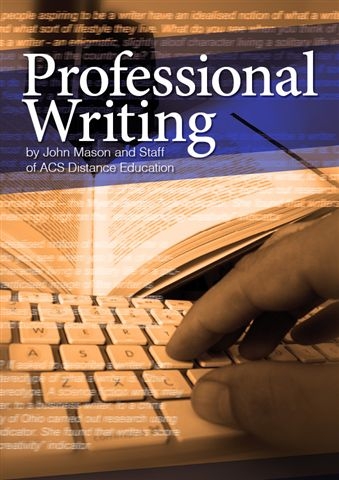 Learn Editing and Proof Reading
Learn Editing and Proof Reading
ACS student comment: "It took me a while, but in the end it was a very useful course for my work. I would like to really thank my tutor for all her feedback which improved my proofreading skills. You will see the results in our catalogue." Premo Jackniacki, Australia - Editing 1 course.
Few people, even professional authors, can write a lucid, well-expressed piece of work. Usually a final draft needs an editor to improve the quality of writing. Editing involves several stages, in summary, they are:
-
Reviewing the manuscript
-
Structural (substantive) editing
-
Copy editing
-
Proof reading
-
Checking proofs.
Editors and proof readers are always in demand; and opportunities to work in this area of the writing world are always likely to exist for anyone who is capable and well trained in these skills.
Course Structure and Content
There are 8 lessons in this course:
- Introduction to Editing
- The role and scope of editing
- Tools for editing
- Editing skills
- The production process
- An overview; who does what in publishing
- The Mechanics of Clear Writing
- Spelling
- Punctuation
- Grammar
- Language
- Style
- Tense
- Assessing Manuscripts
- Readability
- Word length
- Structure
- Consistencies and inaccuracies
- The reader’s report
- Substantive editing
- The author’s responsibilities
- The author/editor relationship
- Copy Editing I
- What the copy editor does
- The procedure
- House style
- Style sheets
- Copy Editing II
- Marking up
- Parts of a publication
- Editing non-text material
- Illustration.
- Preparing Copy for Printing
- Type design
- Page layout
- Proof stages
- Proof Reading
- The Final Stages
- Indexes
- Blurbs
- Checking final proofs
Each lesson culminates in an assignment which is submitted to the school, marked by the school's tutors and returned to you with any relevant suggestions, comments, and if necessary, extra reading.
Course Aims
- To gain an understanding of the role and scope of editing.
- Explain the importance of clear, effective writing, throughout all stages of the publishing process.
- Describe the procedure of manuscript assessment.
- Describe the procedures used by copy editors.
- Explain procedures used to prepare copy for printing.
- Describe the checks and procedures used in the final stages of preparing and printing publications.
Course Duration - 100 hours of self paced study.
Scope of Editing
The scope of editing ranges from self editing, where the writer examines their writing and improves it as best they can, to professional editing, where an expert is employed by a publishing company, author, or other organisation, to improve the quality of a piece of writing prior to publication.
There are many other facets of commercial publishing that require the skills of professional editors. These include commissioning publications; reviewing manuscripts; overseeing manuscripts through the production process; liaising with writers, publishers, printers and agents; writing blurbs, captions and press releases; and researching and organising pictures. In smaller organisations the editor may also be responsible for the design and publication of documents, newsletters, reports, magazines and books using desktop publishing software and equipment.
Working as an Editor
The work of an editor ranges from self editing, where the writer examines their writing and improves it as best they can, to professional editing, where an expert is employed by a publishing company to improve the quality of a piece of writing prior to publication.
There are many other facets of commercial publishing that require the skills of professional editors. These include:
- commissioning publications;
- reviewing manuscripts;
- overseeing manuscripts through the production process;
- liaising with writers, publishers, printers and agents;
- writing blurbs, captions and press releases;
- researching and organising pictures.
In smaller organisations the editor may also be responsible for the design and publication of documents, newsletters, reports, magazines and books using desktop publishing software and equipment.
Every editing job is different in some respect from others, and different editors may be responsible for different tasks. In general, editors do any or all of the following (or may delegate some tasks to others):
- Correct language errors, such as poor grammar, incorrect spelling and punctuation, and ambiguities.
- Identify technical inaccuracies (eg. in a non-fiction book.)
- Improve conciseness and clarity, if and where this is of significance.
- Identify potential legal problems, such as plagiarism, ethical or moral problems, copyright infringements, defamation risks.
- Check for uniformity and appropriateness of content and style, and make or recommend adjustments if necessary.
- Determine whether the content of a manuscript should be deleted or replaced (usually with approval from both the author and publisher).
- Determine whether additional content is required within a manuscript (usually with approval from both the author and publisher).
- Determine the order in which the manuscript is to be published.
- Liaise with all other persons involved in the production of the publication.
- Check and clear copyright material to be used in the publication (for instance, anything which is not the original work of the author should be properly referenced and used only in accordance with the law in any jurisdiction relevant to the publication).
- Prepare preliminary pages and cover, and mark up any end matter, usually in collaboration with the author.
- Prepare instructions for others involved in production, such as the designer, illustrator, typesetter and printer. (This may involve marking up the manuscript, preparing a series of ‘briefs’ and, in some cases, contract or tender documents.)
- Select illustrations, including photographs, tables and drawings from material submitted by the author.
- Identify and source additional illustrations if required (from the author or elsewhere).
- Write marketing material if required (often in collaboration with the author and/or the marketing staff).
- Monitor (and sometimes control) production schedules.
- Check proofs at each stage of production.
- Maintain a record of corrections after production for use in any reprints or new edition.
Editing can be a job that involves a high level of responsibility for any mistakes that may be in the publication. Editing can be very competitive, and the salary may be low as you work your way up to a well paid position. Editing can be a high pressure industry that involves meeting strict print deadlines.
Editing does not suit everyone. You not only need the technical skills, but a nature that is an appropriate balance between being pragmatic and being meticulous. Many editors who struggle to get sufficient work may think they have this balance right; but sometimes the publishers who use them have a different opinion (and after all, it is the publisher who decides who to employ!)

Get an Insight into Professional Writing
Read our principal's book "Professional Writing"
click for details or to buy a copy
Introducing the ACS Online School
ACS was established in 1979 by John Mason, who at the time was lecturing for various colleges (TAFE, Higher Education, University) Community Centers and Council of Adult Education in Australia.
High standards were adopted from the start; for example:
- Tutors hold a 3 year, full time post secondary qualification (outside education)
- Tutors have 5 years relevant experience
- Courses (modules or short courses) are 100 hours duration
- Certificates are generally 600 hours
By adhering to standards ACS has built sound credentials and is regarded and recognized highly by academics and industry professionals globally.
Our philosophy is relatively simple, but not always common in education today:
We believe education should aim to improve a student’s capacity to understand and develop in their chosen field of study; and that a course is a starting point that lays a foundation for future development. We believe quality education requires real life interaction between the teacher and student; and restricting access to tutors can devalue the quality of a course. Education is not just about information (any book or web site can provide that). Good education is a carefully contrived and delivered learning experience that changes the student, improving their ability to function within the discipline they study.
Graduates from ACS have been successful in all types of vocational situations, winning jobs and developing careers in academic positions, through to small business and trades.
We welcome the opportunity to talk (or communicate via email) with any prospective student before they enroll with us. Let us help you make the best choice of course. There are many well established facts regarding education which people often discover when it is too late, for example:
- Over 60% of people do not end up working in the field they studied (even university degree graduates)
- Most people who commence courses (college, polytechnic, TAFE, university) never complete them.
- While some people can earn big money in “some” professions, a qualification is rarely a guarantee for big earnings.
- Being successful in business requires a certain personality type as well as other things
- Most accredited courses take years to develop and approve –which in today’s fast paced world often means they are out of date before you graduate.
Our staff know their industries, and before you even enroll, they can provide very unique insights that can be a great help in helping you choose something that is appropriate and useful for your needs.